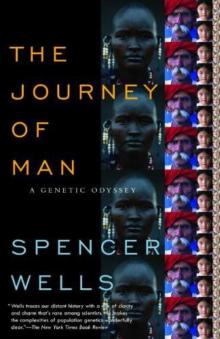Read The Journey of Man: A Genetic Odyssey Storyline:
Around 60,000 years ago, a man—genetically identical to us—lived in Africa. Every person alive today is descended from him. How did this real-life Adam wind up as the father of us all? What happened to the descendants of other men who lived at the same time? And why, if modern humans share a single prehistoric ancestor, do we come in so many sizes, shapes, and races?Examining the hidden secrets of human evolution in our genetic code, Spencer Wells reveals how developments in the revolutionary science of population genetics have made it possible to create a family tree for the whole of humanity. Replete with marvelous anecdotes and remarkable information, from the truth about the real Adam and Eve to the way differing racial types emerged, The Journey of Man is an enthralling, epic tour through the history and development of early humankind.Amazon.com ReviewSpencer Wells traces human evolution back to our very first ancestor in The Journey of Man. Along the way, he sums up the explosive effect of new techniques in genetics on the field of evolutionary biology and all available evidence from the fossil record. Wells's seemingly sexist title is purposeful: he argues that the Y chromosome gives us a unique opportunity to follow our migratory heritage back to a sort of Adam, just as earlier work in mitochondrial DNA allowed the identification of Eve, mother of all Homo sapiens. While his descriptions of the advances made by such luminary scientists as Richard Lewontin and Luigi Luca Cavalli-Sforza can be dry, Wells comes through with sparkling metaphors when it counts, as when he compares genetic drift to a bouillabaisse recipe handed down through a village's generations. Though finding our primal male is an exciting prospect, the real revolution Wells describes is racial. Or rather, nonracial, as he reiterates the scientific truth that our notions of what makes us different from each other are purely cultural, not based in biology. The case for an "out of Africa" scenario of human migration is solid in this book, though Wells makes it clear when he is hypothesizing anything controversial. Readers interested in a fairly technical, but not overwhelming, summary of the remarkable conclusions of 21st-century human evolutionary biology will find The Journey of Man a perfect primer. --Therese LittletonFrom Publishers WeeklyIn this surprisingly accessible book, British geneticist Wells sets out to answer long-standing anthropological questions of where humans came from, how we migrated and when we arrived in such places as Europe and North America. To trace the migration of human beings from our earliest homes in Africa to the farthest reaches of the globe, Wells calls on recent DNA research for support. Clues in the blood of present groups such as eastern Russia's Chukchi, as well as the biological remnants of long-extinct human clans, allow Wells to follow the Y chromosome as a relatively unaltered marker of human heritage. Eventually, working backward through time, he finds that the earliest common "ingredient" in males' genetic soup was found in a man Wells calls the "Eurasian Adam," who lived in Africa between 31,000 and 79,000 years ago. Each subsequent population, isolated from its fellows, gained new genetic markers, creating a map in time and space. Wells writes that the first modern humans "left Africa only 2,000 generations ago" and quickly fanned out across Asia, into Europe, and across the then-extant land bridge into the Americas. Using the same markers, he debunks the notion that Neanderthals were our ancestors, finds odd links between faraway peoples, and-most startlingly-discovers that all Native Americans can be traced to a group of perhaps a dozen people. By explaining his terminology and methods throughout the book, instead of in a chunk, Wells makes following the branches of the human tree seem easy. 44 color photos, 54 halftones and 3 maps. Copyright 2003 Reed Business Information, Inc.Pages of The Journey of Man: A Genetic Odyssey :
